Luminous infrared galaxies or LIRGs are galaxies with luminosities, the measurement of brightness, above 1011 L☉. They are also referred to as submillimeter galaxies (SMGs) through their normal method of detection. LIRGs are more abundant than starburst galaxies, Seyfert galaxies and quasi-stellar objects at comparable luminosity. Infrared galaxies emit more energy in the infrared than at all other wavelengths combined. A LIRG's luminosity is 100 billion times that of the Sun.
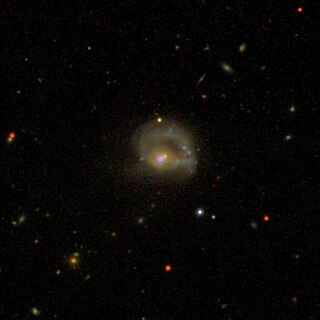
NGC 985 is a ring galaxy in the constellation of Cetus. It is located about 550 million light years away from Earth, which means, given its apparent dimensions, that NGC 985 is approximately 160,000 light years across. It was discovered by Francis Leavenworth in 1886. It is a type 1 Seyfert galaxy.
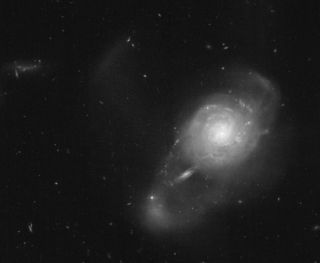
NGC 7679 is a lenticular galaxy with a peculiar morphology in the constellation Pisces. It is located at a distance of about 200 million light years from Earth, which, given its apparent dimensions, means that NGC 7679 is about 60,000 light years across. It was discovered by Heinrich d'Arrest on September 23, 1864. The total infrared luminosity is 1011.05 L☉, and thus it is categorised as a luminous infrared galaxy. NGC 7679 is both a starburst galaxy and a Seyfert galaxy.

Markarian 273 is a galaxy merger located in the constellation Ursa Major. It is located at a distance of about 500 million light years from Earth, which, given its apparent dimensions, means that Markarian 273 is about 130,000 light years across. It is an ultraluminous infrared galaxy and a Seyfert galaxy.

UGC 5101 is a galaxy merger located in the constellation Ursa Major. It is located at a distance of about 530 million light years from Earth. It is an ultraluminous infrared galaxy. The total infrared luminosity of the galaxy is estimated to be 1011.95 L☉ and the galaxy has a total star formation rate of 105 M☉ per year.
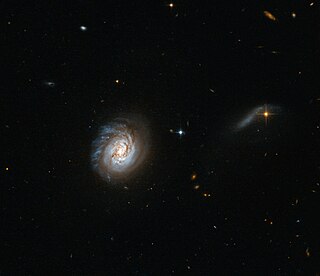
MCG -03-04-014 or PGC 4167, is a spiral galaxy located 450 million light-years in the constellation of Cetus. MCG -03-04-014 is classified as a luminous infrared galaxy, meaning it has high star-formation regions. MCG -03-04-014 has a galactic center that is obscured by dust lanes and presents an abundant supply of molecular gas. The reasons behind the luminosity of this galaxy are debated among astronomers. Some attribute it to recent starbursts, while others point to activity in the galaxies' supermassive black holes. It is also considered that both factors may contribute. The exact cause remains uncertain.

IRAS 14348-1447 known as PGC 52270, are a pair of spiral galaxies located 1 billion light-years away in the constellation of Libra. The galaxy IRAS 14348-1447NE, is in the early process of merging with IRAS 14348-1447SW, causing gravity to pull stars from both galaxies and forming tidal tails. As the interaction takes place, molecular gas is swirled about and creating emission that is responsible for the galaxies' ultraluminous appearance.
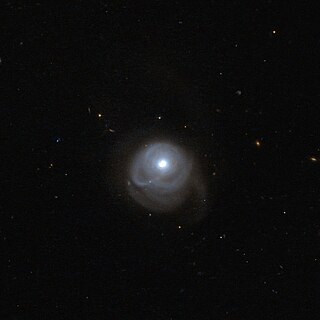
IRAS 05189-2524 is a galaxy merger located in the constellation Lepus. It is located 603 million light-years away from the Solar System and has an approximate diameter of 75,000 light-years.

IRAS F11119+3257 or simply as F11119+3257, is a galaxy located in constellation Ursa Major. With a redshift of 0.187580, it has a light travel time distance of 2.5 billion light-years and is considered an ultraluminous infrared galaxy (ULIRG).

IRAS 09104+4109 is a galaxy located in the constellation Lynx. With a redshift of 0.440797, the light travel time for this galaxy, corresponds to 4.8 billion light-years from Earth. It is the brightest cluster galaxy in MACS J0913.7+4056 galaxy cluster and classified as a hyperluminous infrared galaxy.
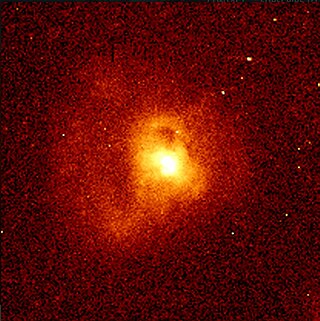
IRAS 13218+0552 known as SFRS 263, is a galaxy merger located in the Virgo constellation. Its redshift is 0.202806, putting the object at 2.6 billion light-years away from Earth. It is a Seyfert galaxy and a luminous infrared galaxy.

PKS 1345+125 known as PKS 1345+12 and 4C +12.50, is an ultraluminous infrared galaxy (ULIG) with an active galactic nucleus, located in the constellation Boötes. With a redshift of 0.121740, the galaxy is located 1.7 billion light-years from Earth.

The South America Galaxy, also known as LEDA 69877 and IRAS 22491-1808, is a merging pair of ultraluminous infrared galaxies located in the constellation Aquarius. It is estimated to be 1.045 million light-years from the Milky Way and about 90,000 light-years in diameter. The object is moving away from the Solar System with a calculated radial velocity of approximately 23.300 kilometers per second.

Markarian 463 known as UGC 8850, is a galaxy merger located in the constellation Boötes. It is located 706 million light years from Earth. It is classified a double nucleus Seyfert galaxy.

IC 4687 known as IRAS 18093-5744 or F18093-5744, is an Sb spiral galaxy located in the constellation of Pavo. It is located 250 million light years from Earth and was discovered by Royal Harwood Frost on August 1, 1904, who described the object "as brighter middle with magnitude of 14. It has a surface brightness of 12.5.

ESO 286-19 known as IRAS 20551-4250, is a galaxy merger located in the constellation of Microscopium. It is located 609 million light years away from Earth. It is an ultraluminous infrared galaxy.

IRAS 10565+2448 known as IRAS F10565+2448, is a galaxy merger located in the constellation of Leo. It is located at a distance of 625 million light years from Earth. It is classified as an ultraluminous infrared galaxy with an infrared luminosity of 1.2 x 1012 LΘ. It has a star formation rate of 131.8 MΘ yr−1.

ESO 148-2 known as ESO 148-IG002 and IRAS 23128-5919, is a galaxy merger located in the constellation of Tucana. It is located 642 million light years from Earth and is classified a Wolf-Rayet galaxy as well as an ultraluminous infrared galaxy.

IRAS 07598+6508 known as IRAS F07599+6508, is a quasar located in the constellation of Camelopardalis. It is located 2.37 billion light years from Earth and is classified as both an ultraluminous infrared galaxy and a Seyfert galaxy.

IRAS 01003-2238 also known as IRAS F01004-2237 or simply F01004-2237, is a galaxy located in the constellation of Cetus. It is located 1.65 billion light years away from Earth and is a Seyfert galaxy and an ultraluminous infrared galaxy. IRAS 01003-2238 is also classified as a Wolf-Rayet galaxy, making the object one of the most distant known.



















